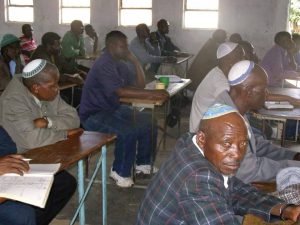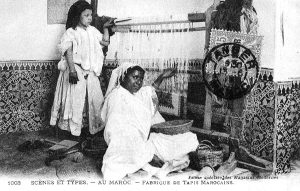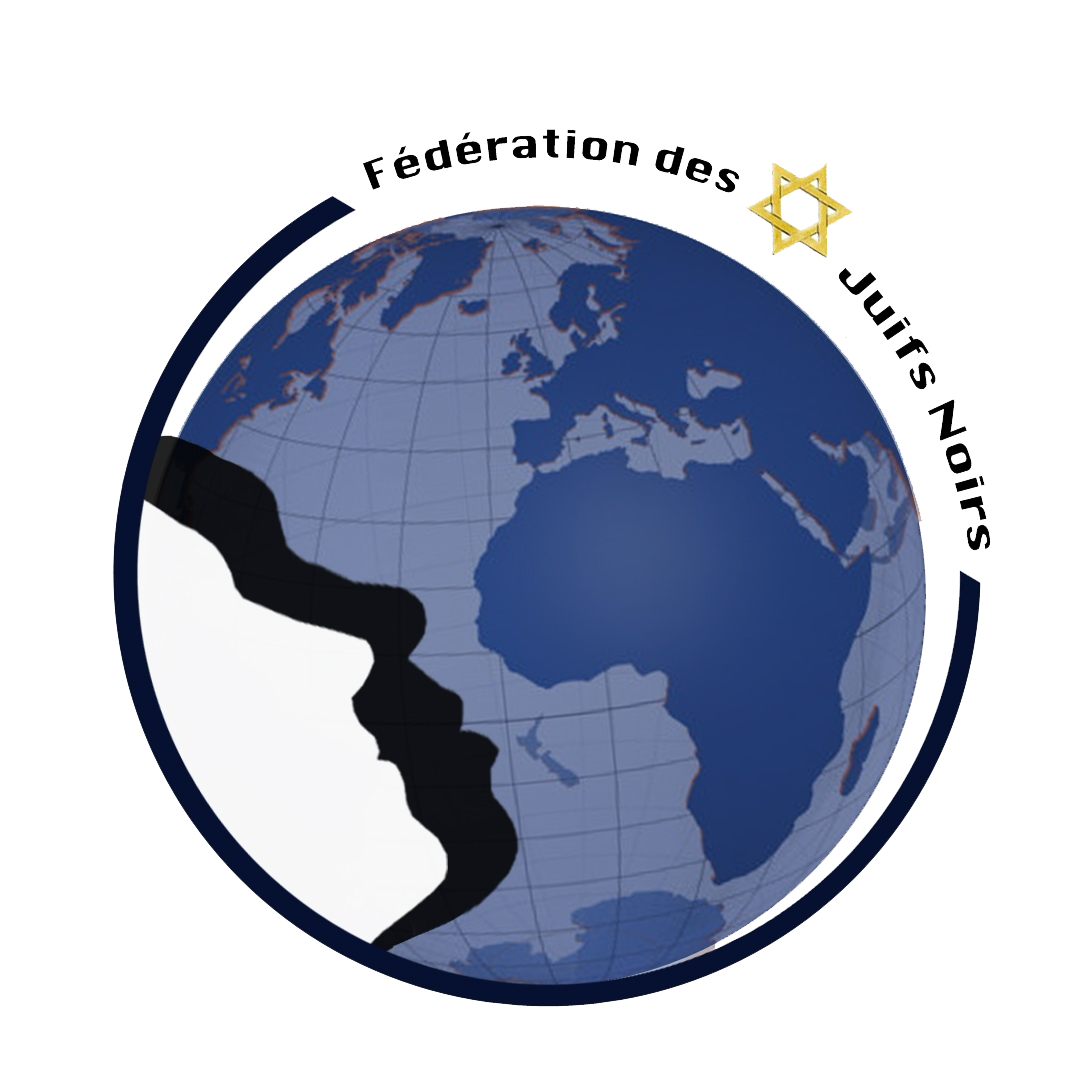 The eleventh and tenth centuries BCE, to expand Jewish influence and facilitate trade, the kings David and Solomon sent Jews to settle in what is now North Africa, the Arabian Peninsula, the Horn of Africa and Nubia, modern Sudan.
The eleventh and tenth centuries BCE, to expand Jewish influence and facilitate trade, the kings David and Solomon sent Jews to settle in what is now North Africa, the Arabian Peninsula, the Horn of Africa and Nubia, modern Sudan.
The ten tribes formed the kingdom of Israel after the destruction of the latter by the Assyrians in the eighth century, were dispersed. Some made their way to Africa, others to Asia or Europe.
In -586, Nebuchadnezzar destroyed the Temple. According to some traditions, Jews fled to Africa. The Babylonians took the people of Judah into captivity.
It is therefore likely that the Jewish presence in Black Africa dates back almost three thousand years. Are these men have preserved traces of their Jewishness ? Perhaps, but not as the Jews of Yemen who maintained contacts with other communities as evidenced by the famous epistle of Maimonides (1135-1204) and praying in Hebrew. Cut off from other communities, folded on themselves, they kept some of the legacy of their ancestors if traditions ?
Take the example of the Marranos of Belmonte, Portugal, that after less than half a century to break with Judaism, had kept only one Hebrew word Adonai, and a semblance of preparation for the feast of Pesach. So after a few thousand years … The geographer Al Idrisi (1100-1165) and the historian Ibn Khaldun (1332-1406) evoke the black Jews.
Shimon Peres reportedly told in 1976 to historian George E. Lichtblauque Leopold Sedar Senghor (1906-2001), the legendary poet of negritude and first president of Senegal said it would have Jewish roots. According to the statesman of Dakar, small groups of Bnei Israel exist in Senegal in Wolof since the Middle Ages. They had to convert to Islam in the eighteenth century.
The latter added that the trilogy of “suffering people” consisted of black Africans, Jews and Arab-Berber. Briefly, here is the story of some of these tribes.
The Jewish kingdom of Tuat, Jews Sahara
The discovery in 1903 of a tombstone, for supporting a well in the Ghormali region attests to this Jewish kingdom disappeared for five centuries and is the first historical record of the Jewish presence in the Tuat region. She mentions the name of the deceased, Mona bat Amram, died on the twentieth day of the second week of the month of Av 5089 (13 July 1309). In 1950, a new index appears Tamentit : a flat stone, fifty kilograms, marked “Maimon, son of Samuel and grand-son of Ben Braham Koubi, who died in 5150 (1390),” is discovered in a village. On this slab, women washing their clothes in public washhouse.
A tombstone bearing the same name was found later, but it disappeared thereafter. Only remains a picture … It is not excluded that other traces appear.
The Jews of Timbuktu and Mali
An AFP report, in March 1996, echoed an article in a newspaper Bamako on The Rise of Mali’s Jewish community. In September 1997, Jacob Oliel, a prominent historian, published in the journal “Los Muestros” an article entitled The Jews of Mali.
He told the detailed discovery of the Judaism, the saga of Rabbi Mordecai Aby Serour. This rabbi guided Charles de Foucauld who intended to enter Timbuktu, forbidden to non-Muslims for five centuries. Mordecai, who dreamed of settling there, had himself admitted and discovered that the Jews had inhabited the area for hundreds of years. The Book of Jacob Oliel from Jerusalem to Timbuktu, the odyssey of Mordecai rabbi, Olbia editions, narrates this epic. The fourteenth and fifteenth centuries, Jews fleeing Spain found refuge in Timbuktu and established three villages : Kirshamba, Haybomoet Kongougara. Their descendants were forced, on pain of death, to embrace Islam in 1492 and became Timbuktu city forbidden to non-Muslims.
Since the 1990s, guided by a historian of Timbuktu, Ismael Haidara Diadié, founder of an association, “Zakhor, Association tombouctite friendship with the Jewish people”, some of their descendants a thousand it would seem, would be to research their Jewish roots.
The Bayuda Congo
In Congo, spread over a territory stretching from Kasai River in Lake Tanganyika lives a major ethnic group, the Baluba. They claim to come from “above”, that is to say from the north. The other groups call them Jews themselves denominate Bayuda, people of Judah. If they say the Jews ? They may see themselves as such. But it would be interesting to research.
The Abayudaya of Uganda
In Uganda, at the end of the nineteenth century English missionaries convert to Protestantism Semei Kakungulu, a powerful warrior of fifty Baganda tribes forming the kingdom of Buganda, promising that he will rule over the other clans. Kakungulu brought under British rule bugandais the territory. But Albion does not keep his promise to her and confines, with his own, in a narrow and cramped area a few kilometers away, near the town of M’bale at the foot of Elgon Mountains.
Kakungulu approaches Malachite, a sect combining Jewish and Christian beliefs, in 1913. He met several Jews working for the colonial administration and seems more attracted to Judaism. He is circumcised in 1919.
He founded a sect Kibina Kya Bayudaya Absesiga Katonda, the community of Jewish people who believe in G-d.
Currently the Abayudaya (people of Judah), formerly the number three thousand, decimated by Idi Amin Dada, the bloodthirsty tyrant who ruled Uganda from 1971 to 1979 are grouped in four villages around M’bale. They are nearly six hundred and has five synagogues, large landscaped spaces with places of prayer, the pediment, a Magen David.
The House of Israel in Ghana
In 1976, Aharon Ahomtre Toakyirafa Tribe Sefwi Suid’Adiembra, a village lost in the bush, has a vision. Spirit him say that he and his people are descendants of the lost tribes of Israel.
Toakyirafa discovers that traditional practices of his people show disturbing similarities with that of the Hebrews, including respect for the Sabbath, the prohibition against eating pork, male circumcision, isolation of the menstruum woman …
Toakyirafa researched and discovered that his family are originally from the Ivory Coast, which some took to Ghana, other reassembled north, perhaps in Timbuktu, where a black Jewish presence is historically attested. Toakyirafa and his clan adopt Judaism and are called “BetaIsraël” House of Israel.
The Ghanaian authorities, unwilling to emerge a new religion, imprisoned the leaders of Beta Israel, but no charges being brought against them, they were forced to the relâcher.Toakyirafa death, David Ahenkorah successor. Today the House of Israel has a few dozen members in an area they called the New Adiembra. They built a synagogue and community buildings.
The Jews of Rusape (Zimbabwe)
Those who call themselves Jews have their origins, according to tradition, to the north. They believe that the similarity of some of their ancestral rites, those relating to the funeral, circumcision, marriage, agriculture, with those of the ancient Hebrews, is troubling. They claim descent from one of the ten lost tribes.
The towering ruins, unique in Africa, not far away, show a brilliant civilization that ruled between the sixteenth and thirteenth centuries. Is it, as they claim (and as claimed by the Lemba of South Africa, their cousins) of a Jewish kingdom ? Historians have not provided any response to date.
At the end of the nineteenth century, God would have appeared to an old black American slave, William Saunders Crowdy, became deacon of the Protestant church ; This vision directed him to bring blacks to Judaism.
In 1903, at the other end of the world, the Ghanaian Albert Christian receives a revelation instructing him to go to America seeking the “prophet of God.”
By an extraordinary coincidence, the two men meet. Albert Christian returns to Africa with the certainty of the Jewishness of his people. It took him thirty years to convince his tribe to follow him. The community has a synagogue, currently has several thousand members and follows the rules of Western Jewry.
 Lembas in South Africa
Lembas in South Africa
The Lembas represent a population of tens of thousands of people, established between Malawi, South Africa and Zimbabwe, whose ancestors were the Israelites of the expedition that led King Solomon to Ophir (in Zimbabwe as their tradition), in search of gold : some remained on site to teach people the belief in one God, “Mwali” .From slightly lighter skin color than their neighbors, Lembas maintain traditions from or like fortaux Jewish : the observance of the new moon, the prohibition against eating pork, funeral rites. If women can, exceptionally, to marry outside the community, the man who is excluded and driven by members of his clan. Their flag has a Star of David.
The Jews of Cape Verde
Following the expulsion of Jews from Spain in 1492, the Catholic kings who married their daughter to the heir to the Portuguese throne, demanded that King Manuel of Portugal expel all Jews in his kingdom. Not wanting to destroy its economic infrastructure, the sovereign decided to convert the whole, by cunning, all Jews. He made the board but just to sail, soldiers threw large tubs of water on passengers while priests baptized them collectively. This subterfuge was endorsed by the church …
Some of these Christaos Novos, these New Christians, wanting to flee the country, landed in Cape Verde. The Portuguese island locked them in a ghetto of the capital, Ribeira Grande.
Over the centuries, these New Christians, completely assimilated, eventually give up and lose all their Jewish practices. In the early nineteenth century, the Jews of Morocco, eager to escape their status as dhimmis, second-class citizens, settled in Cape Verde, an important stopover for coal transportation. They founded a small community. Most of the Jews of Cape Verde emigrate to Israel in the early twentieth century. Do not stay behind the descendants of Jews Lusitanian fifteenth century, a city, Sinagoga, and an abandoned cemetery, being restored through the work of a Belgian doctor Jacques Massart, and an American journalist, Carol Castiel, who have spoken both in “Los Muestros” .São Tome and Principe.
The arrival of Jews in Sao Tome and Principe is dramatic. To duty if the island is habitable, King Manuel of Portugal sent two thousand Jewish children, aged two to twelve years, populate the island. They landed and abandoned on the shore. After a year, there will be six hundred survivors !
In the early seventeenth century, the descendants of these children, although qu’assimilés the local population, continue to Judaize but practices are lost until the arrival, in the early twentieth century, some Jews who establish a community encouraging some of the descendants of these children as nothing but a lighter color, does not distinguish indigenous, discover their history, showing an interest in Judaism of their ancestors.
The Israeli ambassador to Cameroon, Professor Moshe Liba devote, in 2007, an article in “Los Muestros” to these children.
Tutsi of Rwanda and Burundi
The Tutsi people is part of a group of peoples called “Hamitic” in colonial and missionary literature, inhabiting a territory around the White Nile, formerly named in the Bible, Pishon.
This vast region covers the eastern Congo, Rwanda, Burundi and significant parts of Uganda, Kenya and Tanzania. But the Tutsi prefer to describe as “Ethiopians” and refers to the ancient empire of Kusch reigned where the Queen of Sheba and her son Menelik 1 (David II), whose father was King Solomon.
Different ethnic groups have the same origin as the Tusti : Hima (or Hema in eastern Congo), the Maasai of Kenya and Tanzania, the Karamojong, northern Uganda, the Samburu of northern Kenya, etc. .
Monsignor Julien Gorju, head of the Church of Burundi in his face in the United hamite Ruanda, the brother kingdom del’Urundi appeared in 1938 in Brussels (see also the same author, Zigzag through Urundi, published in Namur in 1926, 233 pp.), says that the Tutsis are of Ethiopian descent. It was approved by many other missionaries whose White Father Firmin Rodegem in his Dictionary Rundi / Inyizamvugo y’ikirundi, published in Usumbura in 1961, in which he defines the Tutsi as “éthiopides” (p.1.146).
Both the Bible and the writings of ancient Egypt talk about what is now Ethiopia, as the country of Kush. Tutsi therefore prefer to describe as “Ethiopians” and refer to this kingdom which ruled the Queen of Sheba (Makeda Ethiopian) would be a descendant of Moses and Tsipora, Ethiopian.
The Negus Haile Selassie, King of Kings, does not he doing calling the Lion of Judah ? According Mathias Niyonzima, specialist in the history of his people and initiator of the site, the Jewish origin of the Tutsis is indisputable.
He cites as evidence the law of Veterans which imposes a series of rules that have amazing points of resemblance to the Mosaic law : strict monotheism ancient : Imana is the name of God, kashrut, the “imiziro” who the “mitzvot”, but the red heifer, in addition to this attachment to tradition, the refusal of Christian baptism (the last great kings and leaders Tutsi as Mwezi, Mutaga, Maconco, Rwabugiriet Musinga fought evangelism (until dead for some) and assimilation. the hostility of some Roman Catholic Church and the genocide of which they were victims in culpable indifference, and daily life in an environment dominated by ethnically different populations and often hostile also brings the Jewish people.
 This is a pre Talmudic Judaism that would be similar, according to him, the patriarchs, prophets and kings David and Solomon. Tutsi claim descent from the tribe of Judah. The coup de1966 ended the dynasty of mwamis (kings) of Burundi which was founded by Ntare I Rushatsi Cambaratama (King Leo I “the Hirsute the beast Tunic”) around 1270 AD, and whose five seventeen rulers held the title of Ntare, Leo. At the demonstration on 1 July 2004 in Matonge, this picturesque district of Brussels near the Porte of Namur, a group of demonstrators opposed to the conflict in the Great Lakes region is violently attacked Serge R., calling of “dirty Jew” on the pretext of his Tutsi origin.
This is a pre Talmudic Judaism that would be similar, according to him, the patriarchs, prophets and kings David and Solomon. Tutsi claim descent from the tribe of Judah. The coup de1966 ended the dynasty of mwamis (kings) of Burundi which was founded by Ntare I Rushatsi Cambaratama (King Leo I “the Hirsute the beast Tunic”) around 1270 AD, and whose five seventeen rulers held the title of Ntare, Leo. At the demonstration on 1 July 2004 in Matonge, this picturesque district of Brussels near the Porte of Namur, a group of demonstrators opposed to the conflict in the Great Lakes region is violently attacked Serge R., calling of “dirty Jew” on the pretext of his Tutsi origin.
According to Mathias Niyonzima, some clans still retain their names Hebrew root “ben” (son of), such as Benengwe, Banyakarama, Banyamurenge, Banyiginya. This Jewish collective memory of the Tutsi is also reflected by the adoption of the Star of David on the flag of Burundi.
Bibliography : The Jewish Tutsi. Article by Mathias Niyonzima, “Los Muestros No. 56” – September 2004. There is a communication that happens every time we encounter a Jew, when he shared his sentence and we share ours. Somehow, we agree. I think that has led us to develop good relations with Israel.
© Maurice Dorès
